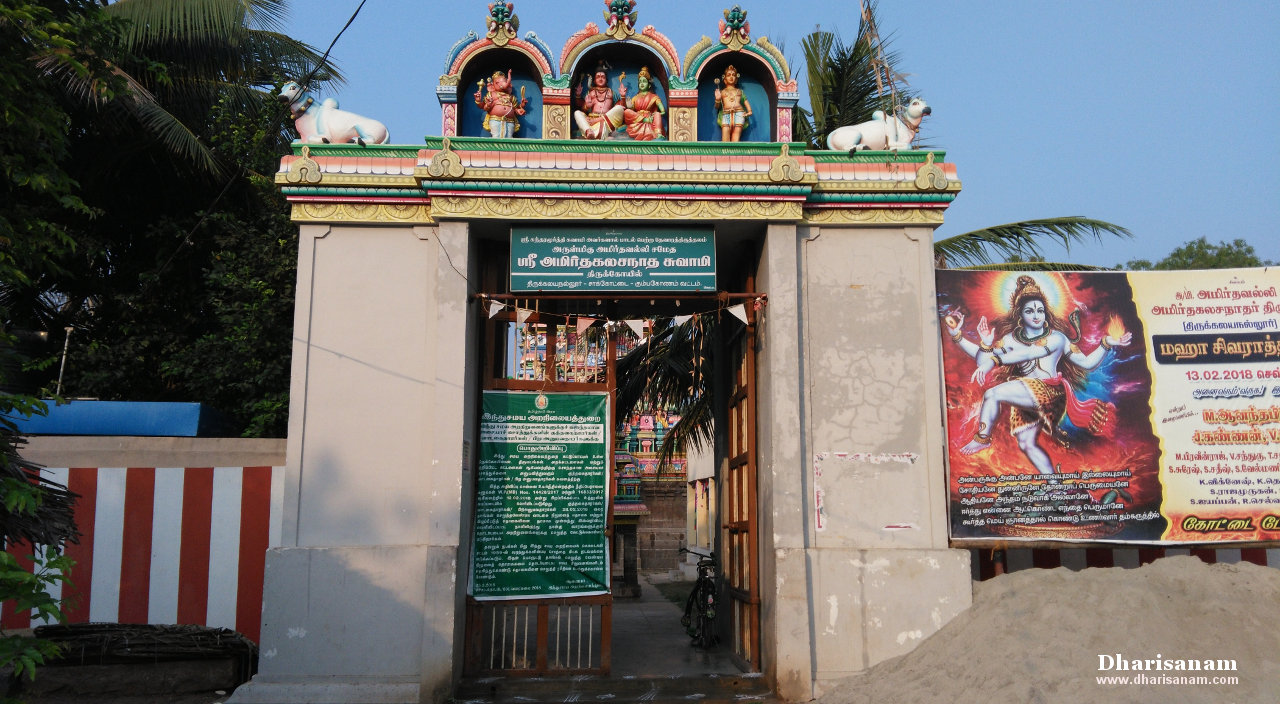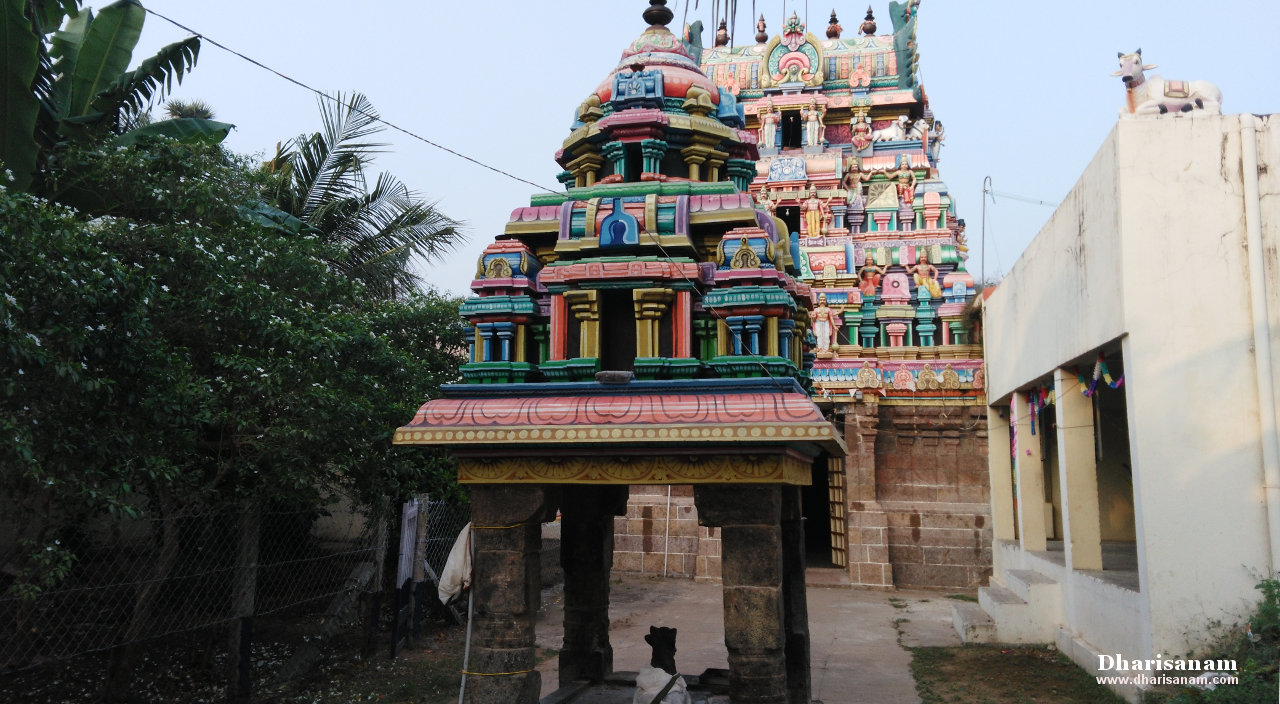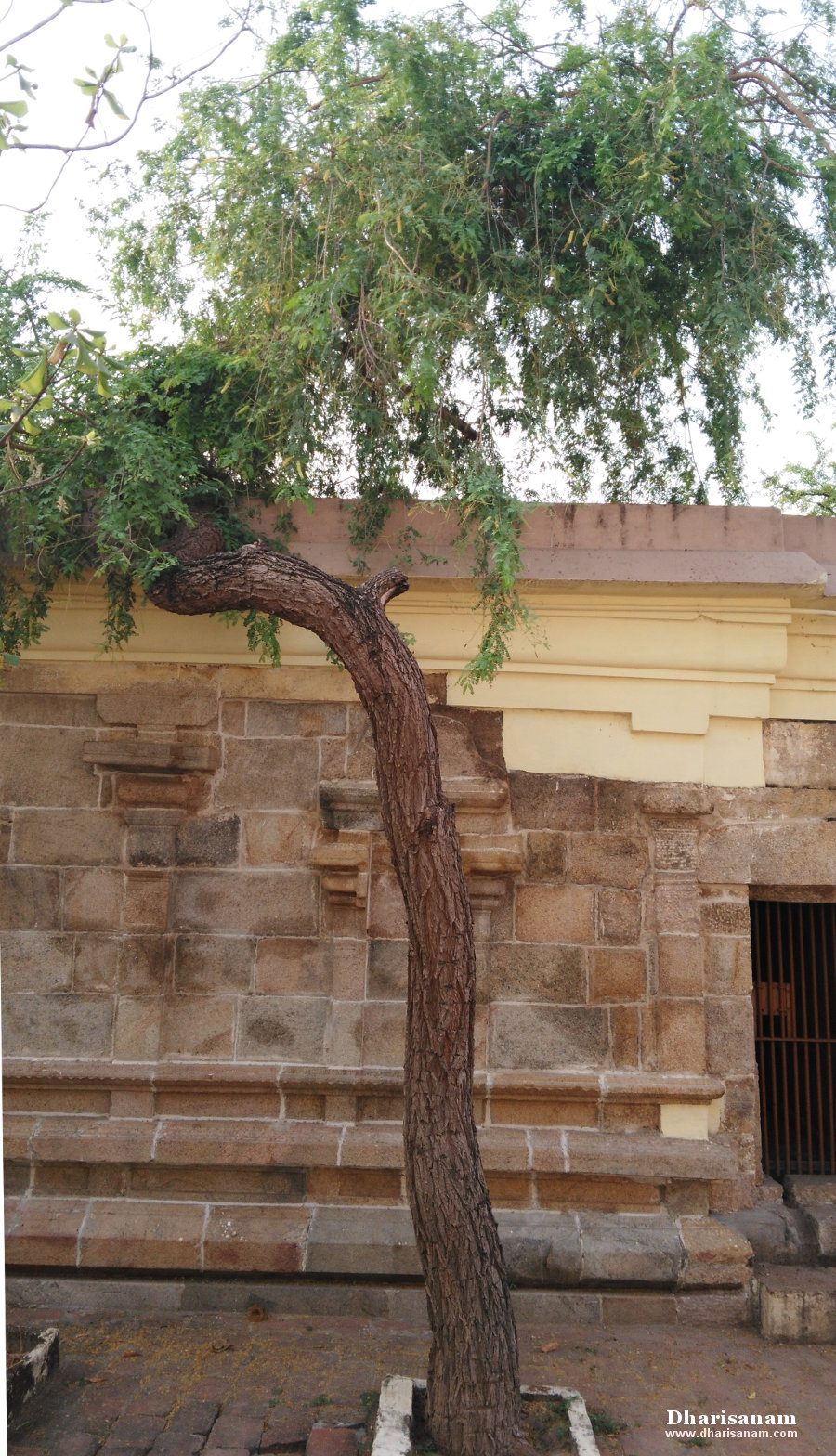Visited on: March 31, 2018.
Location
Kalayanallur is situated at a distance of about 5 kms southeast of Kumbakonam on the Kumbakonam - Needamangalam - Mannarkudi route.
Other Devara Paadal Petra Shiva Sthalam near this place are – Karukkudi, Sivapuram, Kudavasal, Thirucherai, Thalaiyalangaadu, Peruvelur, Karaveeram, Nalur Mayanam, Kaduvaikarai Puthur (Andankoil), Thiru Kollamputhur, Penu Perunthurai, Naraiyur Siththecharam and Arisirkarai Puthur.
General Information
| Moolavar | Sri Amirthakalasa Nathar |
| Ambal | Sri Amirthavalli |
| Theertham (Holy water) | Nankuveda Theertham |
| Sthala Vriksham (Sacred Tree) | Vanni tree |
| Pathigam (Hymn) rendered by | Saint Sundaramurthy (Sundarar)-1 |
- This is one of the 276 Devara Paadal Petra Shiva Sthalams and 68th Shiva Sthalam on the Southern bank of the river Cauveri in Chozha Nadu (Thenkarai).
- Lord Shiva in this temple is a Swayambumurthi (self-manifested).
- This east facing temple has a single corridor and its main tower is not tiered. In place of the Gopuram, there is a beautiful sculpture depicting Lord Shiva and Goddess Parvathy. However, at the second entrance, it has a 3-tiered tower.
- The last consecration ceremony (Maha Kumbabishekam) took place on 22.10.2015 and prior to that on 09.02.1992.
History of the Temple
This ancient temple is situated on the southern bank of the river Arisilaru.
This temple was built in granite by the Cholas. Later it was renovated by the Chola King Kulothungan-III and the Nayakkars.
This temple is also referred to as “Kottai Shiva temple”. It is believed that earlier this temple was surrounded by a big fortress with tanks (Akazhi) around it. The Akazhi was on both sides of the wall of the fortress. However, only the ruins of the wall and the tank can be seen. In his hymn, Saint Sundaramurthy Nayanar sings about the glory and grandeur of this fort, its halls, this temple and its tanks.
It is believed that a lot of Sakkiyas (Buddhist) used to reside here. Hence this place gets the name Sakkiya Kottai which has later been changed to Sakkottai.
Another reason for the name Sakkottai is that Saint Sakkiya Nayanar, one of the 63-Nayanmars, worshiped the lord here. This is despite the fact that he was a Buddhist (Sakkiya). Because of his staunch devotion towards Lord Shiva, it is believed that he was blessed with the darshan of Lord Shiva and Goddess Parvathy. Lord Shiva also blessed him by naming him one of the 63b Nayanmars.
This temple is under the administrative control of the Hindu Religious and Charitable Endowments Department of Government of Tamil Nadu (HR&CE).


This is one of the Saptastanam temples associated with Sri Adhi Kumbeswarar temple, Kumbakonam. Other temples are Kottaiyur, Thiru Valanchuzhi, Darasuram, Swamimalai, Kumbakonam and Melaikkaveri.
12 famous Shiva temples participate in the renowned “Mahaamaham” festival during which “Theerthavaari” happens in the Mahaamaha tank. This festival is celebrated once in 12 years in Kumbakonam. These 12 Shiva temples are:
1.Kasi Viswanathar Temple, Kumbakonam
2.Aadhi Kumbeswarar Temple, Kumbakonam
3.Someswarar Temple, Kumbakonam
4.Nageswarar (Vilvavaneswarar) Temple, Kumbakonam
5.Kalahasteeswarar Temple, Kumbakonam
6.Gauthameswarar (Upaveethanathar) Temple, Kumbakonam
7.Koteeswarar Temple, Kottaiyur
8.Amirthakalasanathar Temple, Kalayanallur
9.Bhanapureeswarar Temple, Kumbakonam
10.Abhimukeswarar Temple, Kumbakonam
11.Aathikambatta Visvanathar Temple, Kumbakonam and
12.Ekambareswarar Temple, Kumbakonam.
Simultaneously, 5 Vaishnava temples from Kumbakonam also participate in this festival. However, instead of their Theerthavaari in Mahaamaha tank, the Theerthavaari happens in the river Kaveri. These Vaishnava temples are:
1. Sri Saarangapani temple
2. Sri Chakrapaani temple
3. Sri Ramaswami temple
4. Sri Rajagopalaswami temple and
5. Sri Aadhivaraha Perumal temple.
Legend
According to Hindu mythology, at the end of every “yuga”, there is a huge flood that leads to the destruction of all living beings in the earth. This is called the “Pralayam”. Lord Shiva, through Lord Brahma, arranged for the seeds of all living organisms and four Vedas and Puranas to be put in a pot (“Amutha Kalas” or Kumbham or Kudam in Tamil) filled with nectar (“amirtham”). This was decorated with flowers and cloth and a string was tied to it. This was kept on top of the Mount Kailash. When the Maha Pralayam started, it destroyed all living creatures on the earth. The Amutha Kalas also got displaced and started floating on the seas for years. Eventually when the Pralayam stopped, the Kalas settled in Kumbakonam. Then Lord Shiva took the form of a hunter (Kiratha Murthy) and split open the pot with his arrow. The life on earth started flourishing again.
It is believed that when Lord Shiva opened the pot with his arrow, the pot broke and the decorative items on it fell in various places across the earth. Each of these pieces became Shivalingams.
These places are -
- Kumbesam – this is the place where the Amutha Kalas stayed. This is presently known as Sri Aadhi Kumbeswarar temple (“Aadhi” means “the very beginning”). It is believed that Lord Kiratha Murthy himself made a Shivalingam with the broken pieces of the Kalas by mixing nectar and sand with it. He worshiped this lingam and stayed back in this place. The Shivalingam is in the shape of the neck of a pot (“Kudamukku” in Tamil).
- Somesam – This is the place where the Kalas’s string (“Uri” / “Sikkam” in Tamil) fell. This place is presently known as Sri Someswarar temple.
- Nagesam – This is the place where the Kalas’s “vilvam” (leaf used in poojas) fell. This place is presently known as Sri Nageswarar temple.
- Abhimugesam – This is the place where the Kalas’s coconut fell. This place is presently known as Sri Abhimugeswarar temple.
- Gautamesam – This is the place where the Kalas’s sacred thread fell. This place is presently known as Sri Gautameswarar temple.
- Kudavoil - This is the place where the Kalas’s rim fell. This place is presently known as Sri Koneswarar temple at Kudavasal.
- Kalayanallur (Saakkottai) – This is the place where the mid-portion of the Kalas fell. This place is presently known as Sri Amirthakalasa Nathar temple.
- Bhanathurai, - This is the place where Lord Shiva broke the Kalas with his arrow. This place is presently known as Sri Bhanapureeswarar temple.
- Maalathivanam – This is the place where the Kalas’s flowers fell. This place is presently known as Sri Aathikampatta Viswanathar temple.
- Sri Kalahastheeswarar Koil – This is the place where the Kalas’s “Chandan” fell.
- Sri Ekambareswarar temple - This is the place where the Kalas’s other decorative items fell.
- Kottaiyur Sri Koteeswarar temple - This is the place where some drops of the nectar fell.
The nectar from the Kalas is believed to have reached the Mahaamaham and Potraamarai tanks.
This nectar is also believed to have spread around an area of about 24 kms. In this radius, there are five Shiva temples which are known as “Panchakurosa Sthalams” (“pancha means five and “kurosa” is a unit of measurement used in ancient times). These temples are Thiruvidaimaruthur, Koranattu Karuppur, Thirunageswaram, Swamimalai, and Dharasuram.
It is believed that Goddess Parvathy performed penance here. There is a separate shrine in the name of “Sri Thapas Amman” in the corridor. (“thapas” means penance in Tamil). Pleased with her penance, it is believed that Lord Shiva married her. In the first stanza of his hymn, Saint Sundarar mentions this legend.
Lord Brahma, Saint Sundaramurthy Nayanar and Saint Sakkiya Nayanar have also worshiped the lord of this temple.
Deities in the temple
Other than the shrines of Lord Shiva and Goddess Parvathy, shrines and idols of Narthana Vinayakar, Dhandayuthapani, Nalvar, Navagraham, Vayu lingam, Prithvi lingam, Theyu lingam, Murugan with his consorts, Ardhanareeswarar, Thapas Amman, Gajalakshmi, Sapthamathas (carved out of a single stone), Bairavar, Pitchandavar, Chandran, Suryan, Saneeswarar, Rahu and Sage Sakkiya Nayanar can be seen in the main hall and corridors.
In the “koshtam” (place surrounding the sanctum sanctorum), idols of Dakshinamurthy, Lingothbhavar (with Mahavishnu and Brahma on his either side), Brahma, Durgai and Chandikeswarar can be seen.








Salient Features
There are separate shrines for Arthanareeswarar and Thapas Amman in the corridor and both these idols are very beautiful. The Thapas Amman is standing on her right leg, her left leg is bent, her right hand is placed on her head and her left hand on her stomach. This is a beautiful posture of penance.
The idol of Dakshinamurthy here is different when compared to the postures seen in other Shiva temples. He is seen with Rudraksham, Agni, Chin Mudra and Suvadi (Palm leaves). There is also a halo around his head (“Surya prabhai”). The kallala tree (peepal) behind him is also very big.
The idol of Lingothbhavar looks very beautiful and it is made out of green colour stone.
Behind the sanctum sanctorum, on either sides of Lord Lingothbavar, there are idols of Lord Mahavishnu and Lord Brahma in a worshipping posture. Devotees can enjoy the darshan of all the three lords (Trimurthys) – Brahma, Vishnu and Shiva. This is considered to be very auspicious.





The front hall (Mandapam) of this temple is designed to look like the forehead of a bat (“Vovval Nethi Mandapam”). In this hall, sculptures of Lord Shiva and Goddess Parvathy can be seen in their wedding form. This looks very beautiful.
Greatness of this temple
This temple is famous for conducting rituals for Sashtiyaptha Poorthy, Bheemaratha Santhi and Sadabishekam (60th, 70th and 80th birthdays respectively).
Important Festivals
Some of the important festivals celebrated in this temple are –
Vinayakar Chaturthi in the Tamil month of Aavani (Aug-Sept),
Navarathri in the Tamil month of Purattasi (Sept-Oct),
Skanda Shashti and Annabishekam in the Tamil month of Aippasi (Oct–Nov),
Thiru Karthikai in the Tamil month of Karthikai (Nov-Dec),
Thiruvadhirai in the Tamil month of Markazhi (Dec-Jan) and
Shivrathri in the Tamil month of Masi (Feb-Mar).
Pradosham is also observed regularly.
Temple Timings
From 09.00 AM to 12.00 Noon and from 05.00 PM to 07.00 PM.
Temple Address
Sri Amirthakalasanatha Swamy Temple,
Kalayanallur (Sakkottai),
Kumbakonam Taluk,
Tanjure District,
Tamil Nadu – 612 401.
Tele: +91 – 435-2414453, 96984 60984.
The temple priests’ Sri Balasakthi Gurukkal and Sri Anand Gurukal can be contacted at +91- 98653 06840, 8973621938 and 97882 02923.





Pathigam (Hymn) with English transliteration
Saint Sundaramurthy Nayanar visited this temple and sang this Pathigam.
Devotees visiting this temple should make it a practice to recite this Pathigam.
குரும்பைமுலை மலர்க்குழலி கொண்டதவங் கண்டு
குறிப்பினொடுஞ் சென்றவள்தன் குணத்தினைநன் கறிந்து
விரும்புவரங் கொடுத்தவளை வேட்டருளிச் செய்த
விண்ணவர்கோன் கண்ணுதலோன் மேவியவூர் வினவில்
அரும்பருகே சுரும்பருவ அறுபதம்பண் பாட
அணிமயில்கள் நடமாடும் அணிபொழில்சூழ் அயலின்
கரும்பருகே கருங்குவளை கண்வளருங் கழனிக்
கமலங்கள் முகமலருங் கலயநல்லூர் காணே.
“Kurumpaimulai malarkkuzhali koṇṭathavaṅ kaṇṭu
kuṟippiṉoṭuñ cheṉṟavaḷthaṉ kuṇaththiṉainaṉ kaṟinthu
virumpuvaraṅ koṭuththavaḷai vēṭṭaruḷich cheytha
viṇṇavarkōṉ kaṇṇuthalōṉ mēviyavūr viṉavil
arumparukē surumparuva aṟupathampaṇ pāṭa
aṇimayilkaḷ naṭamāṭum aṇipozhilchūzh ayaliṉ
karumparukē karuṅkuvaḷai kaṇvaḷaruṅ kazhaṉik
kamalaṅkaḷ mukamalaruṅ kalayanallūr kāṇē”.
செருமேவு சலந்தரனைப் பிளந்தசுடர் ஆழி
செங்கண்மலர் பங்கயமாச் சிறந்தானுக் கருளி
இருள்மேவும் அந்தகன்மேற் றிரிசூலம் பாய்ச்சி
இந்திரனைத் தோள்முரித்த இறையவனூர் வினவில்
பெருமேதை மறையொலியும் பேரிமுழ வொலியும்
பிள்ளையினந் துள்ளிவிளை யாட்டொலியும் பெருகக்
கருமேதி புனல்மண்டக் கயல்மண்டக் கமலங்
களிவண்டின் கணமிரியுங் கலயநல்லூர் காணே.
“Serumēvu salantharaṉaip piḷanthasuṭar āzhi
seṅkaṇmalar paṅkayamāch chiṟanthāṉuk karuḷi
iruḷmēvum anthakaṉmēt ṟirichūlam pāychchi
inthiraṉaith thōḷmuriththa iṟaiyavaṉūr viṉavil
perumēthai maṟaiyoliyum pērimuzha voliyum
piḷḷaiyiṉan thuḷḷiviḷai yāṭṭoliyum perukak
karumēthi puṉalmaṇṭak kayalmaṇṭak kamalaṅ
kaḷivaṇṭiṉ kaṇamiriyuṅ kalayanallūr kāṇē”.
இண்டைமலர் கொண்டுமணல் இலிங்கமது வியற்றி
இனத்தாவின் பாலாட்ட இடறியதா தையைத்தாள்
துண்டமிடு சண்டியடி அண்டர்தொழு தேத்தத்
தொடர்ந்தவனைப் பணிகொண்ட விடங்கனதூர் வினவில்
மண்டபமுங் கோபுரமும் மாளிகைசூ ளிகையும்
மறையொலியும் விழவொலியும் மறுகுநிறை வெய்திக்
கண்டவர்கண் மனங்கவரும் புண்டரிகப் பொய்கைக்
காரிகையார் குடைந்தாடுங் கலயநல்லூர் காணே.
“Iṇṭaimalar koṇṭumaṇal iliṅkamathu viyatṟi
iṉaththāviṉ pālāṭṭa iṭaṟiyathā thaiyaiththāḷ
thuṇṭamiṭu saṇṭiyaṭi aṇṭarthozhu thēththath
thoṭarnthavaṉaip paṇikoṇṭa viṭaṅkaṉathūr viṉavil
maṇṭapamuṅ kōpuramum māḷikaichū ḷikaiyum
maṟaiyoliyum vizhavoliyum maṟukuniṟai veythik
kaṇṭavarkaṇ maṉaṅkavarum puṇṭarikap poykaik
kārikaiyār kuṭainthāṭuṅ kalayanallūr kāṇē”.
மலைமடந்தை விளையாடி வளையாடு கரத்தால்
மகிழ்ந்தவள்கண் புதைத்தலுமே வல்லிருளாய் எல்லா
உலகுடன்றான் மூடவிருள் ஓடும்வகை நெற்றி
ஒற்றைக்கண் படைத்துகந்த உத்தமனூர் வினவில்
அலையடைந்த புனல்பெருகி யானைமருப் பிடறி
அகிலொடுசந் துந்திவரும் அரிசிலின்றென் கரைமேல்
கலையடைந்த கலிகடியந் தணர்ஓமப் புகையாற்
கணமுகில்போன் றணிகிளருங் கலயநல்லூர் காணே.
“Malaimaṭanthai viḷaiyāṭi vaḷaiyāṭu karaththāl
makizhnthavaḷkaṇ puthaiththalumē valliruḷāy ellā
ulakuṭaṉtṟāṉ mūṭaviruḷ ōṭumvakai netṟi
otṟaikkaṇ paṭaiththukantha uththamaṉūr viṉavil
alaiyaṭaintha puṉalperuki yāṉaimarup piṭaṟi
akiloṭusan thunthivarum arisiliṉtṟeṉ karaimēl
kalaiyaṭaintha kalikaṭiyan thaṇar'ōmap pukaiyāṟ
kaṇamukilpōṉt ṟaṇikiḷaruṅ kalayanallūr kāṇē”.
நிற்பானுங் கமலத்தில் இருப்பானும் முதலா
நிறைந்தமரர் குறைந்திரப்ப நினைந்தருளி யவர்க்காய்
வெற்பார்வில் அரவுநாண் எரியம்பால் விரவார்
புரமூன்றும் எரிவித்த விகிர்தனூர் வினவில்
சொற்பால பொருட்பால சுருதியொரு நான்குந்
தோத்திரமும் பலசொல்லித் துதித்திறைதன் றிறத்தே
கற்பாருங் கேட்பாரு மாயெங்கும் நன்கார்
கலைபயிலந் தணர்வாழுங் கலயநல்லூர் காணே.
“Niṟpāṉuṅ kamalaththil iruppāṉum muthalā
niṟainthamarar kuṟainthirappa niṉaintharuḷi yavarkkāy
veṟpārvil aravunāṇ eriyampāl viravār
puramūṉtṟum eriviththa vikirthaṉūr viṉavil
soṟpāla poruṭpāla suruthiyoru nāṉkun
thōththiramum palasollith thuthiththiṟaithaṉt ṟiṟaththē
kaṟpāruṅ kēṭpāru māyeṅkum naṉkār
kalaipayilan thaṇarvāzhuṅ kalayanallūr kāṇē”.
பெற்றிமையொன் றறியாத தக்கனது வேள்விப்
பெருந்தேவர் சிரந்தோள்பல் கரங்கண்பீ டழியச்
செற்றுமதிக் கலைசிதையத் திருவிரலாற் றேய்வித்
தருள்பெருகு சிவபெருமான் சேர்தருமூர் வினவில்
தெற்றுகொடி முல்லையொடு மல்லிகைசெண் பகமுந்
திரைபொருது வருபுனல்சேர் அரிசிலின்றென் கரைமேல்
கற்றின(ம்)நன் கரும்பின்முளை கறிகற்கக் கறவை
கமழ்கழுநீர் கவர்கழனிக் கலயநல்லூர் காணே.
“Petṟimaiyoṉt ṟaṟiyātha thakkaṉathu vēḷvip
perunthēvar siranthōḷpal karaṅkaṇpī ṭazhiyach
chetṟumathik kalaisithaiyath thiruviralāt ṟēyvith
tharuḷperuku sivaperumāṉ sērtharumūr viṉavil
thetṟukoṭi mullaiyoṭu mallikaiseṇ pakamun
thiraiporuthu varupuṉalsēr arisiliṉtṟeṉ karaimēl
katṟiṉa(m)naṉ karumpiṉmuḷai kaṟikaṟkak kaṟavai
kamazhkazhunīr kavarkazhaṉik kalayanallūr kāṇē”.
இலங்கையர்கோன் சிரம்பத்தோ டிருபதுதிண் டோளும்
இற்றலற ஒற்றைவிரல் வெற்பதன்மே லூன்றி
நிலங்கிளர்நீர் நெருப்பொடுகாற் றாகாச மாகி
நிற்பனவும் நடப்பனவாம் நின்மலனூர் வினவிற்
பலங்கள்பல திரையுந்திப் பருமணிபொன் கொழித்துப்
பாதிரிசந் தகிலினொடு கேதகையும் பருகிக்
கலங்குபுனல் அலம்பிவரும் அரிசிலின்றென் கரைமேற்
கயலுகளும் வயல்புடைசூழ் கலயநல்லூர் காணே.
“Ilaṅkaiyarkōṉ sirampaththō ṭirupathuthiṇ ṭhōḷum
itṟalaṟa otṟaiviral veṟpathaṉmē lūṉtṟi
nilaṅkiḷarnīr neruppoṭukāt ṟākāsa māki
niṟpaṉavum naṭappaṉavām niṉmalaṉūr viṉaviṟ
palaṅkaḷpala thiraiyunthip parumaṇipoṉ kozhiththup
pāthirisan thakiliṉoṭu kēthakaiyum parukik
kalaṅkupuṉal alampivarum arisiliṉtṟeṉ karaimēṟ
kayalukaḷum vayalpuṭaichūzh kalayanallūr kāṇē”.
மாலயனுங் காண்பரிய மாலெரியாய் நிமிர்ந்தோன்
வன்னிமதி சென்னிமிசை வைத்தவன்மொய்த் தெழுந்த
வேலைவிட முண்டமணி கண்டன்விடை யூரும்
விமலனுமை யவளோடு மேவியஊர் வினவில்
சோலைமலி குயில்கூவக் கோலமயி லாலச்
சுரும்பொடுவண் டிசைமுரலப் பசுங்கிளிசொற் றுதிக்கக்
காலையிலும் மாலையிலுங் கடவுளடி பணிந்து
கசிந்தமனத் தவர்பயிலுங் கலயநல்லூர் காணே.
“Mālayaṉuṅ kāṇpariya māleriyāy nimirnthōṉ
vaṉṉimathi seṉṉimisai vaiththavaṉmoyth thezhuntha
vēlaiviṭa muṇṭamaṇi kaṇṭaṉviṭai yūrum
vimalaṉumai yavaḷōṭu mēviya'ūr viṉavil
chōlaimali kuyilkūvak kōlamayi lālach
churumpoṭuvaṇ ṭisaimuralap pasuṅkiḷichot ṟuthikkak
kālaiyilum mālaiyiluṅ kaṭavuḷaṭi paṇinthu
kasinthamaṉath thavarpayiluṅ kalayanallūr kāṇē”.
பொரும்பலம துடையசுரன் தாரகனைப் பொருது
பொன்றுவித்த பொருளினைமுன் படைத்துகந்த புனிதன்
கரும்புவிலின் மலர்வாளிக் காமனுடல் வேவக்
கனல்விழித்த கண்ணுதலோன் கருதுமூர் வினவில்
இரும்புனல்வெண் டிரைபெருகி ஏலம்இல வங்கம்
இருகரையும் பொருதலைக்கும் அரிசிலின்தென் கரைமேற்
கரும்புனைவெண் முத்தரும்பிப் பொன்மலர்ந்து பவளக்
கவின்காட்டுங் கடிபொழில்சூழ் கலயநல்லூர் காணே.
“Porumpalama thuṭaiyasuraṉ thārakaṉaip poruthu
poṉtṟuviththa poruḷiṉaimuṉ paṭaiththukantha puṉithaṉ
karumpuviliṉ malarvāḷik kāmaṉuṭal vēvak
kaṉalvizhiththa kaṇṇuthalōṉ karuthumūr viṉavil
irumpuṉalveṇ ṭiraiperuki ēlamila vaṅkam
irukaraiyum poruthalaikkum arisiliṉtheṉ karaimēṟ
karumpuṉaiveṇ muththarumpip poṉmalarnthu pavaḷak
kaviṉkāṭṭuṅ kaṭipozhilchūzh kalayanallūr kāṇē”.
தண்கமலப் பொய்கைபுடை சூழ்ந்தழகார் தலத்திற்
றடங்கொள்பெருங் கோயில்தனிற் றக்கவகை யாலே
வண்கமலத் தயன்முன்னாள் வழிபாடு செய்ய
மகிழ்ந்தருளி இருந்தபரன் மருவியஊர் வினவில்
வெண்கவரி கரும்பீலி வேங்கையொடு கோங்கின்
விரைமலரும் விரவுபுனல் அரிசிலின்தென் கரைமேற்
கண்கமுகின் பூம்பாளை மதுவாசங் கலந்த
கமழ்தென்றல் புகுந்துலவு கலயநல்லூர் காணே.
“Thaṇkamalap poykaipuṭai chūzhnthazhakār thalaththit
ṟaṭaṅkoḷperuṅ kōyilthaṉit ṟakkavakai yālē
vaṇkamalath thayaṉmuṉṉāḷ vazhipāṭu seyya
makizhntharuḷi irunthaparaṉ maruviya'ūr viṉavil
veṇkavari karumpīli vēṅkaiyoṭu kōṅkiṉ
viraimalarum viravupuṉal arisiliṉtheṉ karaimēr
kaṇkamukiṉ pūmpāḷai mathuvāsaṅ kalantha
kamazhtheṉtṟal pukunthulavu kalayanallūr kāṇē”.
தண்புனலும் வெண்மதியுந் தாங்கியசெஞ் சடையன்
தாமரையோன் தலைகலனாக் காமரமுன் பாடி
உண்பலிகொண் டுழல்பரமன் உறையுமூர் நிறைநீர்
ஒழுகுபுனல் அரிசிலின்தென் கலயநல்லூர் அதனை
நண்புடைய நன்சடையன் இசைஞானி சிறுவன்
நாவலர்கோன் ஆரூரன் நாவின்நயந் துரைசெய்
பண்பயிலும் பத்துமிவை பத்திசெய்து நித்தம்
பாடவல்லா ரல்லலொடு பாவமிலர் தாமே.
“Thaṇpuṉalum veṇmathiyun thāṅkiyacheñ chaṭaiyaṉ
thāmaraiyōṉ thalaikalaṉāk kāmaramuṉ pāṭi
uṇpalikoṇ ṭuzhalparamaṉ uṟaiyumūr niṟainīr
ozhukupuṉal arisiliṉtheṉ kalayanallūr athaṉai
naṇpuṭaiya naṉsaṭaiyaṉ isaiñāṉi siṟuvaṉ
nāvalarkōṉ ārūraṉ nāviṉnayan thuraisey
paṇpayilum paththumivai paththiseythu niththam
pāṭavallā rallaloṭu pāvamilar thāmē”.







